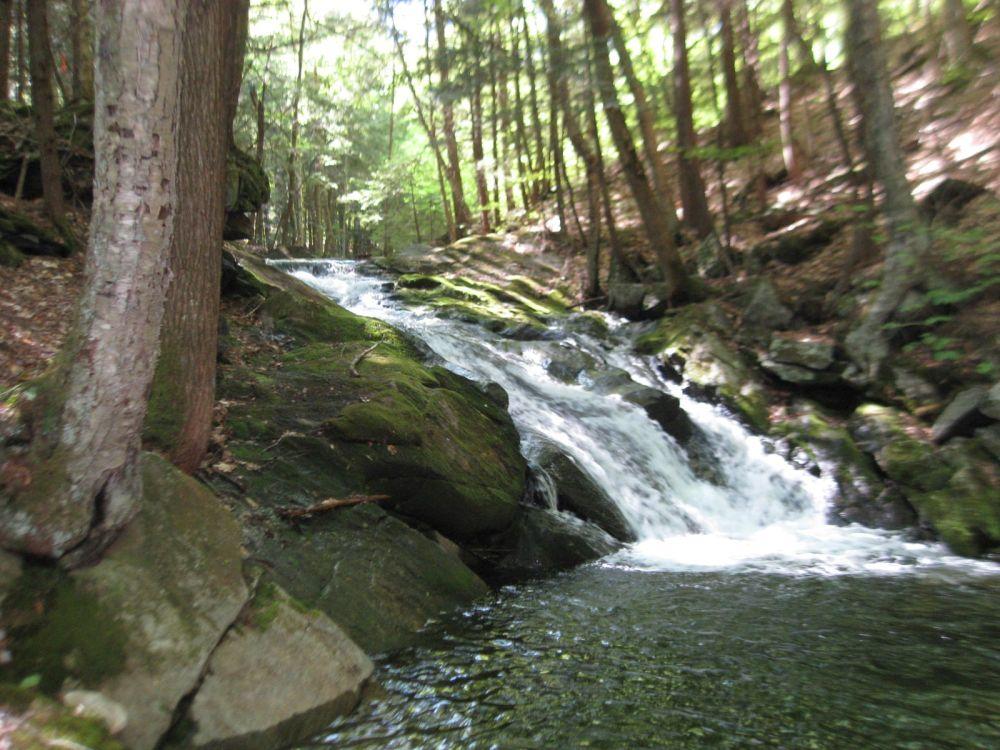
Hazelton Farm conservation easement in Hebron.
Photo by Brian Hotz
Perhaps a landscape sufficiently large and wild enough to fire a child’s imagination might also fire dragon’s breath?
Rolling, open meadows of the Hazelton farm on Wise Brook stretch to the sandy banks of the Cockermouth River. As seen from rural Braley Road at the toe slope of Tenney Mountain in Hebron, the streams drain a scenic hidden valley of the Newfound Lake watershed reminiscent of Shangri-La. The family-owned farm includes more than half a mile of direct frontage on the sandy lower reaches of the Cockermouth River near Sculptured Rocks in adjacent Groton. The property also contains more than a mile of spectacular rocky pools and scenic cascades of upper Wise Brook, a tributary of the Cockermouth River and home to colorful and wary brook trout.
This summer, the Forest Society began a campaign to purchase a conservation easement to forever protect 270 acres of the scenic and historic 300-acre Hazelton farm. If successful, the conservation easement purchase will protect natural and cultural resources including drinking water supplies, productive hay fields, well managed forests and scenic views while expanding the growing regional network of conservation land overlooking Newfound Lake.
Recently, the Forest Society received a note accompanying a contribution from Molly Lu, an 8-year old girl who loves dragons. In lieu of receiving birthday gifts, Molly Lu asked her friends and family to help celebrate her birthday with contributions to protect the Hazelton farm. Her reason was simple: “I dream about dragons using this land” she wrote.
Well-said, Molly Lu.
Originally published in the New Hampshire Sunday News
Dragons are secretive, some would say “mythically” so. Dragon habitat in New Hampshire must be exceedingly rare. Nobody seems to know much about it. It’s been difficult to find reliable information in respected wildlife research publications. It’s likely the internet has more leads but the validity of the information remains suspect.
As a working naturalist, I figure that good dragon habitat must be specialized. Ideally it would feature hot days and be short on knights. As cold-blooded reptiles, dragons need warm places to bask in the sun: south-facing ledges are ideal and afford sweeping views of the surrounding landscape while offering places from which to launch into flight. Jagged ledges and cliffs along a steep, forested ridge leading to nearby Bald Knob on Crosby Mountain would be perfect!

While we’re at it: fire-breathing dragons need access to fire-starting materials and ample water should things become too hot! Ample supplies of dry paper birch bark? Check. Icy-cold pools in a remote mountain brook? Check.
A few caves or talus slopes of jumbled granite boulders would be important options for winter hibernacula. A famous dragon of yore named “Puff” once sadly slipped into his cave when his friend, “Jackie Paper” outgrew faith in make-believe.
That any of us cease to believe in the power of imagination is a great loss.
Our traditional rationale for protecting open space includes scenery, wilderness, clean water, wildlife habitats and the working farmlands and forests which provide both food and wood fiber. We occasionally acknowledge we also protect land for all future generations. Land conservation is a conservative approach, a legacy we bequeath to future generations of children and grandchildren. The transformative power of land conservation reveals how our passion for beloved places can inspire future flights of imagination.
Thanks to Molly Lu for the important reminder: beyond statistics of dollars and acres and habitat associations for a host of native plants and wildlife species, lies the realm of human spirituality and having what naturalist, John Hay once described as “a beginner’s faith in things unseen.”
Who’s to say if firing-up dragon’s breath and firing-up childhood imaginations of untold future generations of NH residents is any less important than our more traditional rationale for conserving special places.
